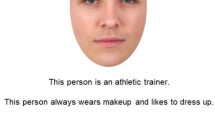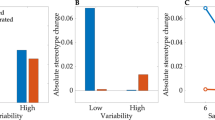Abstract
Stereotypic categorization schemas pertaining to the male gender role are examined in two related studies. Study I provides preliminary evidence for four stereotypic categories and their attributes: Businessman, Athlete, Family Man, and Loser. When compared to a similar study on female stereotypes, male stereotypes appear more weakly held. Study II expanded the populations sampled, employing a hierarchical cluster analysis to analyze responses to a card sorting task using attributes from Study I. Differences were found between the three, primarily Caucasian, subject groups. Results support a social cognitive orientation to understanding stereotypes, which suggests that broad categories, such as “men” or “women,” do not capture the commonly made distinctions within these groups, which are more accurately conceptualized as subtypes.
Similar content being viewed by others
References
Ashmore, R. (1981). Sex stereotypes and implicit personality theory. In D. Hamilton (Ed.), Cognitive processes in stereotyping and intergroup behavior. Hillsdale, NJ: Lawrence Erlbaum.
Ashmore, R. D., & Del Boca, F. K. (1979). Sex stereotypes and implicit personality theory: Toward a cognitive-social psychological conceptualization, Sex Roles, 5, 219–248.
Ashmore, R. D., & Del Boca, F. K. (1981). Conceptual approaches to stereotypes and stereotyping. In D. L. Hamilton (Ed.), Cognitive processes in stereotyping and intergroup behavior. Hillsdale, NJ: Lawrence Erlbaum.
Ashmore, R. D., & Tumia, M. L. (1980). Sex stereotypes and implicit personality theory, I. A personality description approach to the assessment of sex stereotypes. Sex Roles, 6, 501–518.
Ashmore, R. D., Del Boca, F. K., & Wohlers, A. J. (1986). Gender stereotypes. In R. D. Ashmore & F. K. Del Boca (Eds.), The social psychology of female-male relations. Orlando, FL: Academic Press.
Austad, C. S., & Aronson, H. (1987). The salience of sex role instructions to mental health professionals. Sex Roles, 16, 323–333.
Babich, M. (1988). A cognitive approach to the content and structure of the male stereotype. Unpublished master's thesis, University of Rhode Island.
Bernard, J. (1981). The good-provider role. American Psychologist, 36, 1–12.
Block, J. H. (1976). Issues, problems, and pitfalls in assessing sex-differences: A critical review of the psychology of sex differences. Merrill-Palmer Quarterly, 22, 283–308.
Brannon, R. (1978). Measuring attitudes toward women (and otherwise): A methodological critique. In J. A. Sherman & F. L. Denmark (Eds.), The psychology of women: Future directions in research. New York: Psychological Dimensions.
Brewer, M. B., Dull, V., & Lui, L. (1981). Perceptions of the elderly: Stereotypes as prototypes. Journal of Personality and Social Psychology, 41, 656–670.
Broverman, I. K., Vogel, S., Broverman, D., Clarkson, F., & Rosenkrantz, P. (1972). Sex-role stereotypes: A current appraisal. Journal of Social Issues, 28, 59–78.
Cantor, N., & Mischel, W. (1979). Prototypes in person perception. Advances in Experimental Social Psychology, 12, 2–51.
Chapman, L. J., & Chapman, J. P. (1967). Genesis of popular but erroneous psychodiagnostic observations. Journal of Abnormal Psychology, 72, 193–204.
Chapman, L. J., & Chapman, J. P. (1969). Illusory correlation as an obstacle to the use of valid psychodiagnostic signs. Journal of Abnormal Psychology, 74, 271–280.
Cicone, M. V., & Ruble, D. N. (1978). Beliefs about males. Journal of Social Issues, 34, 5–16.
Deaux, K., & Major, B. (1987). Putting gender into context: An interactive model of gender-related behavior. Psychological Review, 94, 369–389.
Deaux, K., Winton, W., Crowley, M., & Lewis, L. L. (1985). Level of categorization and content of gender stereotypes. Social Cognition, 3, 145–167.
Eagly, A. H., & Steffen, V. J. (1984). Gender stereotypes stem from the distribution of women and men into social roles. Journal of Personality and Social Psychology, 46, 735–754.
Edwards, G. H. (1987). The content and structure of the male sex role stereotype. Unpublished master's thesis, University of Rhode Island.
Ehrenreich, B. (1984). The hearts of men. New York: Doubleday.
England, E. M., & Hyland, D. T. (1985). Male categories: Are all men masculine? Paper presented at the 56th annual meeting of the Eastern Psychological Association, Boston, MA.
England, E. M., & Hyland, D. T. (1986). Role-based subcategories of females and males. Paper presented at the 57th annual meeting of the Eastern Psychological Association, New York, NY.
Farrell, W. (1986). Why men are the way they are. New York: McGraw-Hill.
Fiske, S. T. (1987). On the road: Comment on the cognitive stereotyping literature in Pettigrew and Martin. Journal of Social Issues, 43, 113–118.
Fiske, S. T., Neuberg, S. L., Beattie, A. E., & Milberg, S. J. (1987). Category-based and attribute-based reactions to others: Some informational conditions of stereotyping and individuating processes. Journal of Experimental Social Psychology, 23, 399–427.
Franklin, C. (1984). The changing definition of masculinity. New York: Plenum.
Hamilton, D. L. (1981). Stereotyping and intergroup behavior: Some thoughts on the cognitive approach. In D. L. Hamilton (Ed.), Cognitive processes in stereotyping and intergroup behavior. Hillsdale, NJ: Lawrence Erlbaum.
Hamilton, D. L., & Rose, T. L. (1980). Illusory correlation and the maintenance of stereotypic beliefs. Journal of Personality and Social Psychology, 39, 832–845.
Hamilton, D. L., & Trolier, T. K. (1986). Stereotypes and stereotyping: An overview of the cognitive approach. In J. F. Dovidio & S. L. Gaertner (Eds.), Prejudice, discrimination, and racism. Orlando, FL: Academic Press.
Hamilton, S., Rothbart, M., & Dawes, R. M. (1986). Sex bias, diagnosis, and DSM-III. Sex Roles, 15, 269–274.
Hartigan, J. (1988). Cluster analysis of variables. In BMDP statistical software manual (Vol. 2). Los Angeles: The Regents of the University of California.
Krueger, J., & Rothbart, M. (1988). Use of categorical and individuating information in making inferences about personality. Journal of Personality and Social Psychology, 55, 187–195.
Maffeo, P. A. (1982). Gender as a model for mental health. In I. Al-Issa (Ed.), Gender and psychopathology. New York: Academic Press.
McCauley, C., Stitt, C. L., & Segal, M. (1980). Stereotyping: From prejudice to prediction. Psychological Bulletin, 87, 195–208.
Noseworthy, C. M. (1982). A social cognitive analysis of stereotyping. Unpublished doctoral dissertation, University of Rhode Island.
Noseworthy, C. M., & Lott, A. J. (1984). The cognitive organization of gender-stereotypic categories. Personality and Social Psychology Bulletin, 10, 474–481.
Pettigrew, T. F. (1981). Extending the stereotype concept. In D. L. Hamilton (Ed.), Cognitive processes in stereotyping and intergroup behavior. Hillsdale, NJ: Lawrence Erlbaum.
Rosch, E. (1978). Principals of categorization. In E. Rosch & B. Lloyd (Eds.), Cognition and categorization. Hillsdale, NJ: Erlbaum.
Rosch, E., & Mervis, C. (1975). Family resemblance: Studies in the internal structure of categories. Cognitive Psychology, 7, 573–605.
Rosch, E., Mervis, C., Gray, W., Johnson, D., & Boyes-Braem, P. (1976). Basic objects in natural categories. Cognitive Psychology, 8, 382–439.
Ruble, D. N., & Ruble, T. L. (1980). Sex stereotypes. In A. G. Miller (Ed.), In the eye of the beholder: Contemporary issues in stereotyping. New York: Holt, Rinehart, & Winston.
Ryff, C. D. (1987). The place of personality and social structure research in social psychology. Journal of Personality and Social Psychology, 53, 1192–1202.
Sampson, E. E. (1981). Cognitive psychology as ideology. American Psychologist, 36, 730–743.
Sears, D. O. (1986). College sophomores in the laboratory: Influences of a narrow data base on psychology's view of human nature. Journal of Personality and Social Psychology, 51, 515–530.
Shaver, P., Schwartz, J., Kirson, D., & O'Connor, C. (1987). Emotion knowledge: Further exploration of a prototype approach. Journal of Personality and Social Psychology, 52, 1061–1086.
Sheriff, A. C., & McKee, J. P. (1957). Qualitative aspects of beliefs about men and women. Journal of Personality, 25, 451–464.
Snyder, M., Tanke, E. D., & Berscheid, E. (1977). Social perception and interpersonal behavior: On the self-fulfilling nature of social stereotypes. Journal of Personality and Social Psychology, 35, 656–666.
Spence, J. T., Helmreich, R. L., & Stapp, J. (1974). The personal attributes questionnaire: A measure of sex-role stereotypes and masculinity-femininity. JSAS Catalog of Selected Documents in Psychology, 4, 43 (MS No. 617).
Taylor, S. E. (1981). A categorization approach to stereotyping. In D. L. Hamilton (Ed.), Cognitive processes in stereotyping and intergroup behavior. Hillsdale, NJ: Lawrence Erlbaum.
Taylor, S. E., Fiske, S. T., Etcoff, N. L., & Ruderman, A. J. (1978). Categorical and contextual bases of person memory and stereotyping. Journal of Personality and Social Psychology, 36, 778–793.
Thompson, E. H., & Pleck, J. H. (1987). The structure of male role norms. In M. Kimmel (Ed.), Changing men: New directions in research on men and masculinity. Newbury Park, CA: Sage Publications.
Weber, R., & Croker, J. (1983). Cognitive processes in the revision of stereotypic beliefs. Journal of Personality and Social Psychology, 45, 961–977.
Williams, J. E. & Bennett, S. M. (1975). The definition of sex stereotypes via the adjective checklist. Sex Roles, 1, 327–337.
Yount, K. R. (1986). A theory of productive activity: The relationships among self-concept, gender, sex role stereotypes, and work-emergent traits. Sex Roles, 10, 63–88.
Zwick, W. R., & Velicer, W. F. (1982). Factors influencing four rules for determining the number of components to retain. Multivariate Behavioral Research, 17, 253–269.
Author information
Authors and Affiliations
Additional information
The author would like to thank Albert Lott, who served as the director of the research as well as the “expert judge,” and Mark Babich, coresearcher for Study I.
Rights and permissions
About this article
Cite this article
Edwards, G.H. The structure and content of the male gender role stereotype: An exploration of subtypes. Sex Roles 27, 533–551 (1992). https://doi.org/10.1007/BF00290008
Issue Date:
DOI: https://doi.org/10.1007/BF00290008




